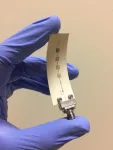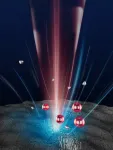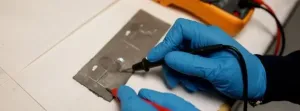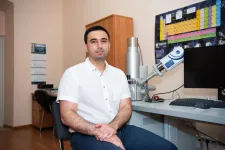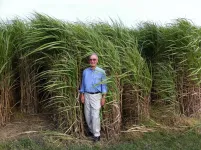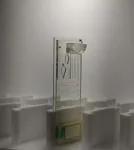(Press-News.org) After suffering a stroke, patients often are unable to use the arm on their affected side. Sometimes, they end up holding it close to their body, with the elbow flexed.
In a new study, Northwestern University and Shirley Ryan AbilityLab researchers have discovered that, in an attempt to adapt to this impairment, muscles actually lose sarcomeres -- their smallest, most basic building blocks.
Stacked end to end (in series) and side to side (in parallel), sarcomeres make up the length and width of muscle fibers. By imaging biceps muscles with three noninvasive methods, the researchers found that stroke patients had fewer sarcomeres along the length of the muscle fiber, resulting in a shorter overall muscle structure.
The research was published today (June 25) in the Proceedings of the National Academy of Arts and Sciences.
This finding is consistent with the common patient experience of abnormally tight, stiff muscles that resist stretching, and it suggests that changes in the muscle potentially amplify existing issues caused by stroke, which is a brain injury. The team hopes this discovery can help improve rehabilitation techniques to rebuild sarcomeres, ultimately helping to ease muscle tightening and shortening.
"This is the most direct evidence yet that chronic impairments, which place a muscle in a shortened position, are associated with the loss of serial sarcomeres in humans," said Wendy Murray, the study's senior author. "Understanding how muscles adapt following impairments is critical to designing more effective clinical interventions to mitigate such adaptations and to improve function following motor impairments."
Murray is a professor of biomedical engineering at Northwestern's McCormick School of Engineering, a professor of physical medicine and rehabilitation at the Northwestern University Feinberg School of Medicine and research scientist at the Shirley Ryan AbilityLab. The research was completed in collaboration with Julius Dewald, professor of physical therapy and human movement sciences and of physical medicine and rehabilitation at Feinberg, professor of biomedical engineering at McCormick, and research scientist at Shirley Ryan AbilityLab.
First demonstration in humans
Measuring just 1.5 to 4.0 microns in length, sarcomeres comprise two main proteins: actin and myosin. When these proteins work together, they enable a muscle to contract and produce force. Although previous animal studies have found that muscles lose serial sarcomeres after a limb is immobilized in a cast, the phenomenon had never before been demonstrated in humans. In the animal studies, muscles that were shorter because they lost serial sarcomeres also became stiffer.
"There is a classic relationship between force and length," said Amy Adkins, a Ph.D. student in Murray's laboratory and the study's first author. "Given that the whole muscle is composed of these building blocks, losing some of them affects how much force the muscle can generate."
To conduct the study in humans, the researchers combined three non-invasive medical imaging techniques: MRI to measure muscle volume, ultrasound to measure bundles of muscle fibers and two-photon microendoscopy to measure the microscopic sarcomeres.
Imaging opens new possibilities
Combining these technologies at Northwestern and Shirley Ryan AbilityLab, the researchers imaged biceps from seven stroke patients and four healthy participants. Because stroke patients are more affected on one side of their body, the researchers compared imaging from the patients' affected side to their unaffected side as well as to images from the healthy participants.
The researchers found that the stroke patients' affected biceps had less volume, shorter muscle fibers and comparable sarcomere lengths. After combining data across scales, they found that affected biceps had fewer sarcomeres in series compared to the unaffected biceps. The differences between stroke patients' arms were greater than in in healthy participants' arms, indicating that the differences were associated with stroke.
By combining medical imaging to better view muscle structure, the study also establishes that it is possible to study muscle adaptations in sarcomere number in humans. Before two-photon microendoscopy, human studies were limited either to examining dissected tissues in anatomy labs, which give imperfect insight into how muscles adapt to injury and impairment, measuring sarcomere lengths during surgery or from a muscle biopsy, which restricts who can participate in the study.
"In almost every facet of our world, there is an important relationship between how something is put together (its structure) and how it works (its function)," the researchers said. "Part of the reason medical imaging is such a valuable resource and clinical tool is that this is also true for the human body, and imaging gives us an opportunity to measure structure."
INFORMATION:
The study, "Serial sarcomere number is substantially decreased within the paretic biceps brachii in individuals with chronic hemiparetic stroke," was supported by the National Science Foundation (award number DGE-1324585) and the National Institutes of Health (R01HD084009).
ROCHESTER, Minn. -- Researchers at Mayo Clinic Cancer Center are studying a potential new chimeric antigen receptor-T cell therapy (CAR-T cell therapy) treatment for multiple myeloma. Their findings were published on Friday, June 24, in The Lancet.
"CAR-T cell therapy is a type of immunotherapy that involves harnessing the power of a person's own immune system by engineering their T cells to recognize and destroy cancer cells," says Yi Lin, M.D., a Mayo Clinic hematologist and lead author of the study.
Dr. Lin says the Food and Drug Administration approved ...
The promise of 5G Internet of Things (IoT) networks requires more scalable and robust communication systems -- ones that deliver drastically higher data rates and lower power consumption per device.
Backscatter radios ? passive sensors that reflect rather than radiate energy ? are known for their low-cost, low-complexity, and battery-free operation, making them a potential key enabler of this future although they typically feature low data rates and their performance strongly depends on the surrounding environment.
Researchers at the Georgia Institute of Technology, Nokia Bell Labs, and Heriot-Watt University have found a low-cost way for backscatter radios to support high-throughput communication and 5G-speed Gb/sec data transfer using only a single transistor when previously ...
Three years ago, Arthur Ashkin won the Nobel Prize for inventing optical tweezers, which use light in the form of a high-powered laser beam to capture and manipulate particles. Despite being created decades ago, optical tweezers still lead to major breakthroughs and are widely used today to study biological systems.
However, optical tweezers do have flaws. The prolonged interaction with the laser beam can alter molecules and particles or damage them with excessive heat.
Researchers at The University of Texas at Austin have created a new version of optical tweezer technology that fixes this problem, a development ...
Want a smartphone that stretches, takes damage, and still doesn't miss a call?
A team of Virginia Tech researchers from the Department of Mechanical Engineering and the Macromolecules Innovation Institute has created a new type of soft electronics, paving the way for devices that are self-healing, reconfigurable, and recyclable. These skin-like circuits are soft and stretchy, sustain numerous damage events under load without losing electrical conductivity, and can be recycled to generate new circuits at the end of a product's life.
Led by Assistant Professor Michael Bartlett, the team recently published its findings in END ...
Scientists from the National University of Science and Technology "MISIS" (NUST MISIS) in cooperation with their colleagues from the Siberian Federal University and the Research and Production Centre of Magnetic Hydrodynamics (Krasnoyarsk) have developed a technology for producing a unique heat-resistant aluminium alloy with improved durability.
According to the researchers, this new alloy could replace more expensive and heavier copper conductors in aircraft and high-speed rail transport. The study results were published in an interdisciplinary, peer-reviewed journal, the Materials Letters. (https://www.sciencedirect.com/science/article/abs/pii/S0167577X2100896X)
Researchers have created a method for producing ...
Night and day, oil tankers, yachts and cargo ships stacked with shipping containers ply the 80-kilometer (50-mile) waterway through the jungles of Panama between the Atlantic and the Pacific Ocean: about 40 ships every 24 hours. But even though the Canal is fed by freshwater rivers that empty through the locks on each end, a system that generally prevents fish and smaller marine invertebrates from hopping from ocean to ocean, some still manage to get through, clinging to the hulls of ships. Other invading species arrive from far-flung ports, dumped with ballast water as ships prepare for transit.
"Panama is a major shipping hub that provides amazing opportunities to test key ideas about marine invasions by studying ...
A team of engineers and clinicians has developed an ultra-thin, inflatable device that can be used to treat the most severe forms of pain without the need for invasive surgery.
The device, developed by researchers at the University of Cambridge, uses a combination of soft robotic fabrication techniques, ultra-thin electronics and microfluidics.
The device is so thin - about the width of a human hair - that it can be rolled up into a tiny cylinder, inserted into a needle, and implanted into the epidural space of the spinal column, the same area ...
A new electrode that could free up 20% more light from organic light-emitting diodes has been developed at the University of Michigan. It could help extend the battery life of smartphones and laptops, or make next-gen televisions and displays much more energy efficient.
The approach prevents light from being trapped in the light-emitting part of an OLED, enabling OLEDs to maintain brightness while using less power. In addition, the electrode is easy to fit into existing processes for making OLED displays and light fixtures.
"With our approach, you can do it all in ...
More corn is grown in the United States than any other crop, but we only use a small part of the plant for food and fuel production; once people have harvested the kernels, the inedible leaves, stalks and cobs are left over. If this plant matter, called corn stover, could be efficiently fermented into ethanol the way corn kernels are, stover could be a large-scale, renewable source of fuel.
"Stover is produced in huge amounts, on the scale of petroleum," said Whitehead Institute Member and Massachusetts Institute of Technology (MIT) biology professor Gerald Fink. "But there are enormous technical challenges to using them cheaply to create biofuels and other important chemicals."
And so, year after year, most of the woody corn material is left in the fields to rot.
Now, a ...
DURHAM, N.C. - Biomedical engineers at Duke University have demonstrated a tablet-sized device that can reliably detect multiple COVID-19 antibodies and biomarkers simultaneously.
Initial results show the test can distinguish between antibodies produced in response to SARS-CoV-2 and four other coronaviruses with 100% accuracy.
The researchers are now working to see if the easy-to-use, energy-independent, point-of-care device can be used to predict the severity of a COVID-19 infection or a person's immunity against variants of the virus.
Having also recently shown the same "D4 assay" platform can detect Ebola infections a day earlier than the gold standard polymerase chain reaction (PCR) test, the researchers say the results show how flexible the technology can be to adapt to other ...
